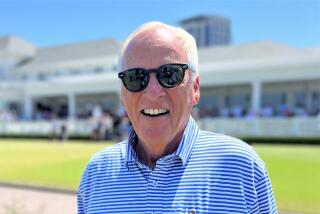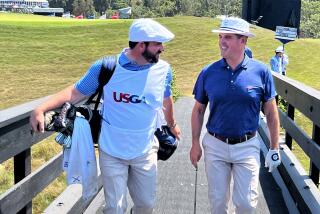Tournament the Players Ache to Play
CARLSBAD — It was an audacious idea. Golf in 1953 was hardly the megabuck industry it has become. Lew Worsham, the leading money winner that year, picked up $34,002 for the whole season, most of that in one atypical private one-man tournament that died a short time later.
The leading money winner last year got $653,296. The guy who finished 157th on the money list, Jim Dent, got more money than Worsham did in ’53 for finishing first.
The total purse money on the tour in 1953 was $562,704. Last year, it was $25,442,242.
You can’t ascribe all this affluence to the Tournament of Champions, a little refinement on medal golf play thought up in Las Vegas in 1953.
But a lot of it, you can.
Golf as a real estate huckster had been pretty well established by ‘53, but this was the first time it had ever been used as a shill for a crap table.
Not everybody liked the idea at the time. Ben Hogan, for instance. Hogan had lit up the game of golf that year as it has never been ignited since. He won five of the seven tournaments he entered, including the Masters, U.S. Open and British Open.
But, he frowned on a tournament as a front for a wheel. So did Jackie Burke and Gene Sarazen. The Tournament of Champions was in a crossfire before it got out of its crib.
Its format, the brainchild of the Las Vegas golf pro, Howard Capps, was so simple, it was a surprise no one had ever thought of it. You didn’t get invited to this tournament or exempted into it by a sponsor or given allowance for an impressive amateur record, you got in for doing one of the hardest things to do in the world of sport--winning a PGA tournament.
The idea was so good, the tournament survived. It was played on a kind of makeshift golf course out behind the slots and baccarat tables and the din of the paging telephones but it wasn’t just another tour tournament, it was a happening.
For one thing, the golfers were treated like visiting royalty. If you think that wasn’t unusual in the early ‘50s, you just don’t know your country-club set. In that pre-TV era, golf players occupied somewhat the same social status as the guy who comes to fix your plumbing or wash your car. They didn’t exactly use the tradesmen’s entrance--they did until Walter Hagen came along--but they were considered just a cut above caddies or the guy who shined your shoes.
Las Vegas has always had the most massive inferiority complex of any city in America. Well aware that it comes into public focus as a place that might turn you into a pillar of salt if you look back on it, it has striven constantly for the kind of respectability a major golf tournament endows the community with.
So, when it got one, it went all out. It not only made the golfers feel wanted, it made them feel courted. Every player in its tournament, even the last placer, got money--$1,000 then, $8,000 today. You could shoot four 90s and go home with money.
Rooms, food and beverages were all comped. Golfers got better treatment than the Hapsburgs in their prime. They wore special identifying jackets, which meant the whole town was free to them.
The $35,000 purse was $15,000 more than the U.S. Open, no less. The $10,000 first money was $4,000 more than the U.S. Open.
The T. of C. was shrewdly masterminded into one of the fixtures on the American sports scene by Allard Roen, one of the general partners of the host Desert Inn.
Roen perceived early that the T. of C. had to add another dimension to golf just to keep its place in the family of sponsors.
It had one of the earliest tie-ins with charity. At that time, almost overshadowing the golf, it had a mammoth open bidding event, called in golf a Calcutta, in which a roomful of high-rollers would bid for golfers in a ballroom auction the night before play.
Calcuttas were not new to golf but this one was. Top players began to be bid in at nearly $50,000, and the total pool began to soar toward a million. Ten percent of it went to charity, the Damon Runyon Cancer Fund, dear to the heart of the powerful journalist, Walter Winchell.
Roen quickly decided that these kinds of numbers were threatening to the tournament. The Calcutta got so high that the 10% of his winnings the Calcutta winner gave to Mike Souchak the year he won it was more than he got for winning the tournament. Roen axed the Calcutta and took the charity cut out of the tournament budget.
Even so, the powers that be in golf had never been comfortable with the gambling backdrop.
That problem was almost solved by, of all people, Howard Hughes. In the throes of runaway eccentricity, Hughes bought the Desert Inn in 1966 but decided he didn’t want the golf tournament.
Roen and company then brought the event to this spa site hard by the metropolis of San Diego on a tract of land where he had gone horseback riding on summer vacations.
That took it far from the sound and sights of the green felt tables and slots. Still, it could not escape its checkered past.
The fathers of golf made another attempt to wrest the tournament, and its format, from Roen a few years ago, but the golfers themselves rose up in mutiny. They liked the front-parlor treatment and the perks, and the commissioner of golf relented.
The format, amusingly enough, has been picked up, no less, by that Vatican of golf, the Masters. It has also been adopted by the commissioner’s pet, the World Series of Golf.
The T. of C. has been a beleaguered event since its inception. But it is now in its 36th year of continuous operation, 400 miles from its slot machine, poker-dealing origins.
The game of golf has not been besmirched, the players are still treated like czars on holidays, and if you want to hear it criticized don’t go to anybody who putts for a living and who would probably have to shoot four 68s any place else to come away with the $8,000 he gets here just for showing up. A player hankers to win any other tournament. This one, he just yearns to get in.
More to Read
Go beyond the scoreboard
Get the latest on L.A.'s teams in the daily Sports Report newsletter.
You may occasionally receive promotional content from the Los Angeles Times.










